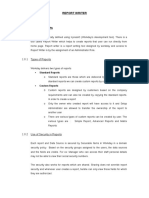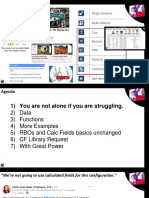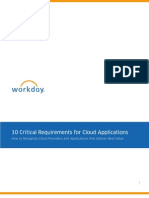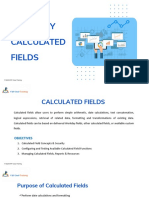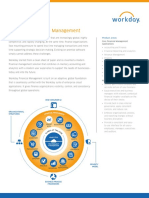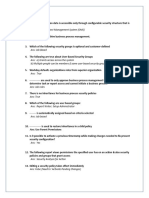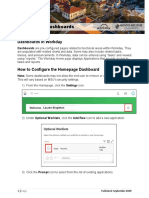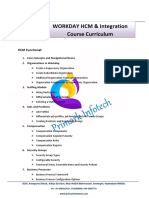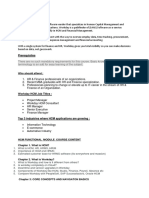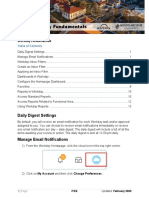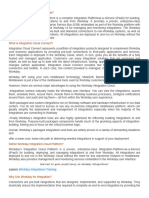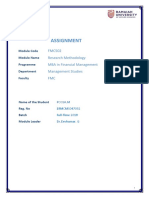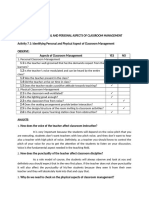Workday Integration On Demand Whitepaper
Uploaded by
Jitesh GandhiCopyright:
Available Formats
Workday Integration On Demand Whitepaper
Uploaded by
Jitesh GandhiOriginal Title
Copyright
Available Formats
Share this document
Did you find this document useful?
Is this content inappropriate?
Copyright:
Available Formats
Workday Integration On Demand Whitepaper
Uploaded by
Jitesh GandhiCopyright:
Available Formats
Simplifying Enterprise Integration
with the Workday Integration Cloud
Simplifying Enterprise Integration
with the Workday Integration Cloud
Contents
The Burden of Enterprise Systems Integration
The Problem with Traditional ERP
The Workday Approach: Integration in the Cloud 3
Why Use Workday for Integration?
Workday Embraces Open, Standards-Based
4
4
Web Services APIs
The integration of enterprise systems is an expensive and
complex issue for most IT organizations. Regardless of the
applicationson-premise, cloud-based, or a combination
of bothsystems integrations typically eat away a good
percentage of most IT budgets. Instead of innovating and
adding direct value to the business, IT staffs are spending
more and more time on their integration infrastructure
Workday Integration Cloud Platform
Powerful Integration Tools Simplify Custom
Integrations for Both Business and IT
Enterprise Interface Builder (EIB)
The Burden of Enterprise System Integration
(e.g., middleware upgrades, security patches, database
updates, and router replacements).
Do not assume you have to shoulder the heavy burden of
Outbound EIBs 6
Inbound EIBs 6
Workday Studio 7
enterprise systems integrations alone. Different systems,
disparate technologies, continuously growing costs,
never-ending maintenance, and immeasurable support
headacheswith issues such as these, isnt it time to
demand more from your solutions provider? Modern
enterprise vendors like Workday are ready to help.
What Is Workday Studio?
When to Use Workday Studio
Workday Integration Cloud Connect
What Is a Packaged Integration?
the need for information, data-processing, and
What Is a Connector?
communication compatibilities with other systems.
The Problem with Traditional ERP
Traditional ERP applications were built primarily on a
client-server model that did not take into consideration
Putting It All Together: Payments Example
11
The Workday Developer Network
12
Workdays Vision: Simplifying Integration
in the Cloud
12
To remedy this disconnect, application programming
interfaces (APIs) were added later to accommodate
system-to-system integration. This low-level approach
increased the options available for integrations, but
unfortunately also greatly increased the cost and
complexity of building and supporting them. In addition,
much of the integration to traditional ERP was completed
at a data level using SQL. Typically, achieving a more
comprehensive integration from the ERP system
to necessary bolt-on systems required significant
programming, which only added to the cost, complexity,
and rigidity of these integrations.
2
To simplify systems integration, Workday provides the
The Workday Approach: Integration in the Cloud
following solutions and tools:
Human capital, payroll, and financial management
systems necessarily need to interact in a variety of
ways with other internal and external systems and
1. Open, Standards-Based Web Services APIs. At the
data sources. Unlike traditional enterprise application
foundation of our approach, Workday provides
providers, Workday understands the importance of
comprehensive standards-based web services APIs
integration to core systems of record and started with
to support all integrations to and from Workday.
integration as fundamental architectural and application
design criteria. Workdays approach is for connectivity
2. Integration Cloud Platform. The Workday
to other applications and resources to be simpler
Integration Cloud Platform is a proven, enterprise-
to build, deploy, manage, and evolve over timea
class integration platform as a service (iPaaS) that
significant and long- awaited change from the cost,
enables Workday, customers, and partners to build
complexity, and rigidity of connecting to traditional
integrations to and from Workday and deploy and
enterprise systems. By offering a variety of packaged
manage them in the Workday Cloud.
solutions and integration tools as well as the ability
3. Integration Cloud Connect. Workday offers a
to deploy integrations to the Workday Cloud, Workday
helps to relieve customers of the historical burden of
growing ecosystem of packaged integrations and
systems integration.
connectors to customers. These offerings are 100%
built, supported, and maintained by Workday as
well as run and managed in the Workday Cloud.
This vendor-supported approach significantly shifts
the cost, risk, and burden of integrations from the
customer to Workday.
Workdays
The
WorkdayIntegration
IntegrationCloud
Cloud
Workday Cloud
Workday Applications
Public Web Service APIs
Custom APIs
Workday Integration Cloud
Integration Cloud Platform
Integration Cloud Connect
Cloud
Applications
On-Premise
Applications
Custom Integrations
Benefits
Providers
Payroll
Providers
LDAP/AD
Why Use Workday for Integration?
These web services-based APIs provide an integration
Clearly, you can build any integration you want against
format (SOAP/WSDL or REST) that is interoperable with
the Workday API using your own middleware technology
all the leading client-side languages and integration
of choice, for example Microsoft.NET, TIBCO, or Oracle
middleware platforms. In addition, the Workday APIs
Fusion Middleware. Many Workday customers do just
are fully versioned, which means customers that build
that. However, there are several major advantages to
an integration against any particular release of Workday
using the Workday Integration Cloud:
are guaranteed those integrations will continue to work
Integrations surface naturally inside the Workday
user interface. You can view the integrations,
launch them, schedule them, secure them, include
them in Workday business processes, configure
across future Workday updates.
The Workday APIs contains the following categories of service:
Business Management Services are the primary way
notifications around them, and audit and log them
to programmatically interact with Workday and
all from within the application.
directly correspond with the major functional areas
of Workday (e.g., Staffing, Benefits, or Financial
Both packaged and custom integrations run on
Management). The operations within these services
Workdays software and hardware infrastructure in
correspond with business events and business
our data centers. You do not need to license or use
objects within Workday (such as Hire Employee
any on-premise integration middleware, which can
within Staffing or Get Journal within Financial
greatly simplify the deployment and management
Management). Operations return extensive data sets
of integrations.
but can also be configured via Response Groups
to return a subset of possible data (e.g., contact
Finally, although completely based on open
information, position information, etc.)
standards, Workdays integration tools are also
highly optimized for efficiently building
Reporting Services, also known as Reports-as-aService (RaaS), provide a flexible, user-defined
integrations to and from Workday. Purpose-built
means to get data out of Workday. All of the reports
packaged components that handle much of the
created using Workdays built-in report writer can
plumbing aspects of integration-building free you
be set up to deliver data via RSS, REST XML, or
to focus on the critical business logic.
traditional SOAP-based messages with the simple
click of a checkbox. This includes customer-defined
Overall, Workdays packaged integrations and tools are
calculated fields.
widely proven in a variety of demanding situations and
offer a lower-cost, lower-risk path to delivering needed
integrations in support of your deployment.
Reporting Services effectively provide a mechanism
within Workday for customers to define and create
their own custom APIs. If only a subset of fields
Workday Embraces Open, Standards-Based
within Workday Human Capital Management
Web Services APIs
services are needed for a specific integration, then
At the core of Workday are open, standards-based APIs
a custom API that contains only those needed fields
that give complete programmatic access to business
can be built. This API can then be consumed by
operations and processes.
Workday or any third-party integration tool.
real- time notifications to external applications
Workday Integration Cloud Platform Workdays
Integration Cloud
when business events occur within Workday. For
Platform is a proven, enterprise-class Integration
example, the workflow behind the Hire event
Platform-as a-Service (iPaaS) for building, deploying,
in Workday could be configured to publish an
and managing integrations to and from Workday. All
outbound message to a subscribing third- party
integrations are deployed to and run in the Workday
system. Upon receipt of the real-time notification,
Cloud without the need for any on-premise middleware.
the subscribing system could then query Workday
Workday also provides management and monitoring
(using the public API) to get details about the
services embedded in the Workday user interface.
Outbound Messaging Services are used to provide
Hire (e.g., employee information, job related
Powering all of Workdays integration capabilities is a
information, etc.) and then take appropriate action.
best-of-breed Enterprise Service Bus (ESB) architecture
that enables Workdays integrations to scale, interconnect,
Infrastructure Services expose Workday metadata
and support the latest industry standards, protocols,
to external applications so integrations can be
and formats. Workdays ESB is a core component of the
enriched with additional functionality. For example,
Workday Integration Cloud and provides universal and
external applications can monitor the execution
open standards- based connectivity for virtually all types
of integration events that are happening within
of business applications, information, and processes.
Workday. With this metadata, external applications
can see not only the status of their current
integrations but also gain insight into when and
how data will come from Workday prior to the
events occurring. This type of transparency gives
business users greater visibility into inter-system
processing than ever before.
Integration Cloud Platform
Workday Integration Tools
Design, Build, Test, & Deploy
Enterprise Class ESB Grid
Transport
Mediate
Route
Transform
Orchestrate
Secure
Workday UI
Manage & Monitor
Powerful Integration Tools Simplify Custom
1. Get Data
Integrations for Both Business and IT Workday offers
In the Get Data phase, a data source is
a set of easy-to-use integration tools designed to
designated. In 95% of cases, this is a custom report
solve many of the common integration use cases that
(RaaS). If you are specifying a Report Data Source,
customers face today.
you can choose the format in which the report
results are delivered: normal XML, simplified XML,
Enterprise Interface Builder (EIB)
CSV, JSON, GData, or RSS. Dont worry if these
The Workday Enterprise Interface Builder (EIB) tool
sound confusingthey just mean you can get data
provides an easy-to-use graphical and guided interface
straight out of the system in a variety of formats
to define inbound and outbound integrations without
which may minimize or remove the need for
requiring any programming. The EIB tool can be used
subsequent transformation. You can also specify a
by both business and IT users to address a variety of
Workday Web Service endpoint as the data source
integration needs.
for an EIB.
Outbound EIBs
2. Transform
At this point, you can either choose from the set of
predefined (XSL) transforms, or specify a new one
that you will define. The out-of-the-box options
include transforms to CSV and Excel formats. New
transforms must be uploaded as valid XSLTs.
Outbound EIBs are used to extract information from
the Workday system, and either attach it back to the
customers tenant for future use or reference or send it
somewhere for further processing. Over three-quarters
of outbound EIBs currently in production send a file to an
external destination via ftp. To create an outbound EIB,
users need to only take three steps:
3. Deliver
The output resulting from executing the EIB
can either be attached back to your tenant, or
alternatively delivered to an external endpoint.
Supported transports are SFTP, FTPS, HTTPS, email,
WebDav, and AS/2. You can optionally compress
or encrypt documents with a PGP key. You can
also control the created filename, any sequence
numbers, and document retention policies where
appropriate. Once an EIB is defined, it can be
run by any authorized user. When it runs to
completion, its status (and any associated output
files) can be viewed by searching for the EIB run
(and its associated integration event record).
Inbound EIBs
Workday Studio
What Is Workday Studio?
Workday Studio is a powerful development tool
enabling customers and partners to build sophisticated
integrations to and from Workday. These integrations are
deployed and run on your behalf on integration servers
in Workdays data center.
For a number of use cases, especially bulk ones, it
is convenient to upload information directly to the
Aimed at skilled developers and offered as a set of
Workday system. In this case, an inbound file is provided
plug-ins to the Eclipse IDE, Workday Studio offers a rich,
and associated with a custom transformation. This
graphical development environment in which a user can
transformation will convert the data into a format
drag and drop a variety of reusable components that
suitable for sending to a particular Workday Web Service.
handle the plumbing aspects of integration building,
It is a mirror-image of the outbound EIB use case.
freeing you to focus on the critical business logic.
Workday has been using this valuable tool for years to
deliver all of our packaged integrations and connectors as
well as the EIB.
In order to simplify this process, Workday generates a
default spreadsheet for the most common set of bulk
update operations. These operations include mass payroll,
time off, benefit adjustments, etc. All you need to do is
take this generated spreadsheet, add data to it, and then
use EIB to import it to the system and update all the
records. The system will proactively notify you of any
errors in the load process, and will even highlight which
cells in the input spreadsheet caused the problem. These
delivered spreadsheets can also be customized so you can
specifically identify the columns you need, add comments
to help guide other users who will be inputting the data,
hide irrelevant fields, etc.
Use Workday Studio to unlock the power of Workdays
integration infrastructure:
Run your Workday Studio integrations like
any other Workday integrationconfigure,
launch, schedule, monitor, and even audit your
integrations.
Use powerful and productive development tools
optimized for interacting with your Workday
tenant.
Build sophisticated and highly customizable
integrations without the need to own or manage
any on-premise integration middleware or servers.
When to Use Workday Studio
What Is a Packaged Integration?
If the integration you want to develop has any one of
Workday offers customers complete packaged
the following characteristics, it is a good candidate for a
integration solutions that are built on an open,
Workday Studio integration:
standards-based API and hosted within the Workday
Multiple different data sources and/or delivery
requirements
Scalable and efficient processing of potentially
very large data sets (up to tens of gigabytes)
Complex looping or branching logic based on
dynamic data or external variables
Sophisticated change detection requirements
Complex error scenarios and corresponding need to
react differently to error conditions
Need for rigorous source code control, unit testing,
debugging, logging, and other formal development
disciplines
Need to extend with custom capabilities implemented
in Java, Spring, or a third-party service
Need to develop related integrations for other
services which also offer an Eclipse-based
development environment
Cloud. This set of integration solutions is delivered,
maintained, and supported by Workday and currently
includes integration to 160+ benefit carriers, Kronos,
TalentLink, Safeguard, Salesforce, Cybersource, and
others. Packaged integrations allow customers to
leverage their current investments without adding
additional costs and overhead within their IT
departments.
What Is a Connector?
In addition to packaged integrations, Workday also
provides Connectors, which are slightly different
from packaged integrations in that they provide a
framework for building an integration of a certain
type based on integration templates. Examples of
Connectors include the Workday Payroll Interface,
which reduces the time, cost, and complexity of
integrating to third-party payroll providers.
Connectors are configured integrations that generate
an intermediate file output format that contains all the
Workday Integration Cloud Connect
needed data and is subsequently transformed to (or
Workday Integration Cloud Connect consists of a growing
from) a specific vendor format. For example, Workday
number of packaged integrations and connectors to
generates a Workday format document, expressed
complementary solutions that are 100% built, supported,
as either XML or CSV, for connecting to a third-party
and maintained by Workday. The benefits of this
payroll system that may not be offered as a packaged
approach to the customer are many, including access to a
integration. In this case, you can then simply do the
set of integrations that are:
last mile yourself (using Workdays integration tools),
lower cost, lower risk, and faster to deploy without
requiring any coding;
leveraging the packaged Connector, which already
represents a large part of the effort.
fully supported by Workday and are certified and
tested across updates and patches; and
treated like any other part of the product, with a
published product roadmap.
Other Connectors, such as the Payment Connector and
Cloud Connect for Workday Payroll - Extends
the Punchout Connector, are built to standards that are
Workday Payroll by integrating to partners that
well structured and consistently adopted by third-party
provide capabilities, including: time and attendance,
systems. In these cases, customers can configure these
tax filing, check printing, and direct deposit.
Connectors to work with any third-party system (e.g., a
Cloud Connect for Third-Party Payroll - Extends
bank or supplier) that adheres to the standard.
Workday HCM by providing integrations to thirdIntegration Cloud Connect consists of the following six
party payroll providers and aggregators.
sub-networks:
Cloud Connect for Spend Management - Extends
Cloud Connect for HCM - Extends Workday HCM
Workday Spend Management by integrating to
by integrating to partners that provide capabilities
partners that provide capabilities, including:
including: recruiting, learning, time and attendance,
electronic payments, corporate card transactions,
and account provisioning (LDAP/Active Directory).
and support for punchout to vendors.
Cloud Connect for Benefits - Extends Workday
HCM by providing integration to a growing catalog
of benefits providers, including: health insurance,
health and flexible spending accounts, retirement
savings plans, life insurance, AD&D insurance, and
COBRA administrators.
Packaged
Cloud
Connect for
Workday
Payroll
Cloud
Connect for
Financials
Cloud
Connect for
Expenses and
Procurement
Medical, Dental,
and Vision
ADP and Ceridian
Tax Filing
Salesforce
Sales Cloud
American
Express
Lumessse
TalentLink
Life and AD&D
Insurance
Ceridian Check
Printing
Cybersource
Bank of
America Visa
Chatter
COBRA
KronosWorker
and Time Data
Kronos
Worker Data
Retirement
Plans
E-verify
Flexible Spending
Accounts
Cloud
Connect
for HCM
Cloud
Connect for
Benefits
Cornerstone
OnDemand
Cloud
Connect for
Third-Party
Payroll
Citibank
Visa
AngelPoints
Connector
Directory
Services
Core
Connectors
Payroll
Connector
FSA
Worker
Sync
Organization
Payments
Payments
Punchout
Payroll
Inputs
Bank
Statements
Supplier
Network
Location
Job Profile and
Job Family
10
Cloud Connect for Financials - Extends Workday
3. Once the integration completes, forward a
Financials by integrating to partners that provide
reference to the generated document to a second
capabilities, including: customer relationship
(Workday Studio built) integration, which further
management, electronic payments, and customer
processes this output by transforming it into a new
payments via credit card.
file format.
Putting It All Together: Payments Example
4. Subsequent to this, and again from within the
One of the first examples shipped with Workday Studio
business process framework, initiate an approval
shows how to create a one-time-payments integration
and delivery sequence whereby the final file
to a third-party payroll vendor. This sample combines a
proposed for delivery to the payroll vendor can be
number of aspects of the integration approach that has
reviewed and approved in a normal workflow.
been described in this document :
1. Use a packaged connector to define the behavior of
5. Once approvals are complete, deliver the file to the
configured third-party endpoint, again powered by
the base one-time-payments integration.
the business process framework.
2. Call this integration on a scheduled basis from
All of the above is fully logged and audited, and any
within a business process.
issues or errors that arise along the way can readily be
corrected and the process re-started.
Business Process
Step 1: Launch
Step 2: Launch
picof.xml
PICOF PayData Extract
Integration
Step 3: Launch
.csv file
Workday Studio PayData
Integration
Delivery Service
Completion Integration Event
11
The Workday Developer Network
Workdays Vision: Simplifying Integration in the Cloud
The Workday Developer Network is an online community
Until now, the best option offered by traditional ERP
for developers to collaborate around Workday applications
vendors to support integration to their solutions was a
and integrations. This developer network provides a
low-level API. With the emergence of SaaS as a delivery
variety of resources and training material on Workdays
model for enterprise solutions, innovative vendors
integration solutions as well as the opportunity to interact
such as Workday are providing new approaches that
with the Workday ecosystem. Get all the latest news
simplify the creation, deployment, and maintenance of
relating to Workdays integration offerings and view the
integrations. Just as Workday simplifies the deployment,
latest Workday Web Service API documentation, or take
management, and upgrades associated with enterprise
part in discussions on the forums, contribute an article, or
applications through a SaaS-based delivery model,
share some useful code youve written. Workday is also
Workday also simplifies application integration by
committed to providing a rich ongoing supply of real-
moving the development, deployment, and management
world sample integrations which you can use as a basis for
of integrations to the Workday Integration Cloud.
your development efforts.
Visit our Workday Developer Network for more
information about our cloud-based approach to integration.
Workday, Inc. | 6230 Stoneridge Mall Road | Pleasanton, CA 94588 | United States
1.925.951.9000 | 1.877.WORKDAY (1.877.967.5329) | Fax: 1.925.951.9001 | www.workday.com
2012. Workday, Inc. All rights reserved. Workday and the Workday logo are registered trademarks of Workday, Inc. All other brand and product names are trademarks
or registered trademarks of their respective holders. SIMPLIFYENI-11092012
You might also like
- Loading Bulk Data Into Workday Using Eib: Steps100% (3)Loading Bulk Data Into Workday Using Eib: Steps17 pages
- Workday API v30.2 - Import - Payroll - Input Operation DetailsNo ratings yetWorkday API v30.2 - Import - Payroll - Input Operation Details32 pages
- Workday Human Capital Management DatasheetNo ratings yetWorkday Human Capital Management Datasheet4 pages
- Glossary Workday Terminology Business Users100% (1)Glossary Workday Terminology Business Users17 pages
- Workday Integration On Demand Whitepaper - Official100% (1)Workday Integration On Demand Whitepaper - Official11 pages
- Workday Integration On Demand Whitepaper PDFNo ratings yetWorkday Integration On Demand Whitepaper PDF5 pages
- Glossary of Workday Integration Terms 1681975352100% (1)Glossary of Workday Integration Terms 168197535212 pages
- Workday Knowledge Management Training Catalog 1 PDF75% (4)Workday Knowledge Management Training Catalog 1 PDF35 pages
- Calc Fields Networking and Sharing: Welcome To100% (1)Calc Fields Networking and Sharing: Welcome To42 pages
- Move Workers (Supervisory) : Training For HR Analysts 6 March 2017No ratings yetMove Workers (Supervisory) : Training For HR Analysts 6 March 201731 pages
- Workday 10 Critical Requirements WhitepaperNo ratings yetWorkday 10 Critical Requirements Whitepaper7 pages
- Workday Calculated Fields: © 2020 ERP Cloud Training100% (1)Workday Calculated Fields: © 2020 ERP Cloud Training33 pages
- Workday Oregon - Security Roles Descriptions PDF100% (1)Workday Oregon - Security Roles Descriptions PDF4 pages
- The Enterprise Cloud For HR & Finance - Sherry AmosNo ratings yetThe Enterprise Cloud For HR & Finance - Sherry Amos10 pages
- Typically Payroll Interface Requirements: - Requirements Are Often Expressed Like ThisNo ratings yetTypically Payroll Interface Requirements: - Requirements Are Often Expressed Like This56 pages
- Pure Worship: Sermon Shared by Howard StricklandNo ratings yetPure Worship: Sermon Shared by Howard Strickland3 pages
- Animal Adaptations Mrs. Campbell's Third Grade Week of November 30No ratings yetAnimal Adaptations Mrs. Campbell's Third Grade Week of November 306 pages
- Soal & Kunci Jawaban Bahasa Inggris Kelas VIII Semester GanjilNo ratings yetSoal & Kunci Jawaban Bahasa Inggris Kelas VIII Semester Ganjil4 pages
- A Twin-Screw Rotor Profile Design and Computational Fluid Dynamic Simulation MethodNo ratings yetA Twin-Screw Rotor Profile Design and Computational Fluid Dynamic Simulation Method6 pages
- Assignment: FMC502 Research Methodology MBA in Financial Management Management Studies FMCNo ratings yetAssignment: FMC502 Research Methodology MBA in Financial Management Management Studies FMC19 pages
- Gung Ho: 1.what Differences Does The Film Highlight Between American and Japanese Business Culture?No ratings yetGung Ho: 1.what Differences Does The Film Highlight Between American and Japanese Business Culture?2 pages
- Workday API v30.2 - Import - Payroll - Input Operation DetailsWorkday API v30.2 - Import - Payroll - Input Operation Details
- Workday Integration On Demand Whitepaper - OfficialWorkday Integration On Demand Whitepaper - Official
- Workday Knowledge Management Training Catalog 1 PDFWorkday Knowledge Management Training Catalog 1 PDF
- Move Workers (Supervisory) : Training For HR Analysts 6 March 2017Move Workers (Supervisory) : Training For HR Analysts 6 March 2017
- Workday Calculated Fields: © 2020 ERP Cloud TrainingWorkday Calculated Fields: © 2020 ERP Cloud Training
- The Enterprise Cloud For HR & Finance - Sherry AmosThe Enterprise Cloud For HR & Finance - Sherry Amos
- Typically Payroll Interface Requirements: - Requirements Are Often Expressed Like ThisTypically Payroll Interface Requirements: - Requirements Are Often Expressed Like This
- Animal Adaptations Mrs. Campbell's Third Grade Week of November 30Animal Adaptations Mrs. Campbell's Third Grade Week of November 30
- Soal & Kunci Jawaban Bahasa Inggris Kelas VIII Semester GanjilSoal & Kunci Jawaban Bahasa Inggris Kelas VIII Semester Ganjil
- A Twin-Screw Rotor Profile Design and Computational Fluid Dynamic Simulation MethodA Twin-Screw Rotor Profile Design and Computational Fluid Dynamic Simulation Method
- Assignment: FMC502 Research Methodology MBA in Financial Management Management Studies FMCAssignment: FMC502 Research Methodology MBA in Financial Management Management Studies FMC
- Gung Ho: 1.what Differences Does The Film Highlight Between American and Japanese Business Culture?Gung Ho: 1.what Differences Does The Film Highlight Between American and Japanese Business Culture?









